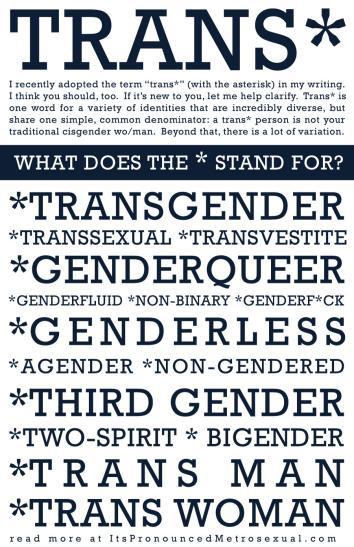It’s widely accepted that computer-mediated communication—emailing, texting, sexting, commenting, chatting, and so on—has changed the way we speak, even when we’re away from the keyboard. But a new label being embraced online by some transgender people may represent a linguistic first: borrowing from computer language itself.
The label in question is trans*, and the asterisk stems from common computing usage wherein it represents a wildcard—any number of other characters attached to the original prefix. Thus, a computer search for trans* might pull up transmission, transitory, or transsexual. But in this neologism, the * is used metaphorically to capture all the identities—from drag queen to genderqueer—that fall outside traditional gender norms. (The asterisk usually goes unpronounced in spoken English, though some users do say “trans star” or “trans asterisk” for clarity’s sake.)
“It was about 2009 or 2010 when I started using trans* to describe my own experiences,” says Nash Jones, who works as the Bridge 13 Community Education Program Coordinator at the Q Center, an LGBTQ center in Portland, Ore. Like many of those who embrace the term, Jones is under 30, college-educated, and actively seeks out “queer and trans* spaces.” Jones, who uses “they” as their gender pronoun, says that they use trans* both as a personal label and as “a more inclusive, broader umbrella term than transgender.”
For most of the last two decades, transgender has been the umbrella term of choice, much as trans* is being positioned today. Labels like transmasculine, or transvestite were considered to denote specific identities that fell within its scope. Before that, the most widely used term was usually transsexual, which fell out of favor in part because it focused attention narrowly on physical sex. Today, transsexual is usually used to refer to someone who wants to undergo gender reassignment surgeries (Confused? Here is a handy list of terms from the National Center for Transgender Equality.)
For some, the appeal of trans* might be similar. By removing -gender, which instinctively brings to mind images of men or women, trans* might help transcend the gender binary and provide more space for people who are in the middle, who move back and forth, or who don’t identify with the binary at all.

Image provided by Cristan Williams
As transgender gained ascendancy in the 1990s, many lesbian and gay organizations, pressured to present at least a veneer of inclusivity, added it to their names or mission statements. It’s possible that a younger generation turned against the term in part because the spread of the word transgender was often accompanied by little in the way of significant change to include actual trans* people.
Jenny Lederer is a San Francisco State University lecturer in linguistics who studies the metaphors by which people understand gender transition. She likens this falling out of favor to the cognitive linguistic concept of salient exemplars, which are “complex but relatively well-shared societal prototypes attached to any given label.” She suggests that “this younger generation of trans-folks want to disassociate” from the few famous transgender people they’ve seen, because those celebrities don’t seem relevant or similar to their lives. Instead, they’re looking to the Internet to find—or create—words, communities, and celebrities with which they feel comfortable.
There doesn’t seem to be a definitive answer to when and where trans* first came into usage. But it seems clear from its roots in computer language, anecdotal research, and the fact that no one agrees on how to say it aloud, that trans* first—and recently—appeared online.
But trans historian Cristan Williams cautions against leaping to any conclusions. “In talking with older trans community members, they tell me that they had used t* as a short code for all things trans back in the early 1980s message boards.” She believes the word may well be gaining popularity as a way of sidestepping an ongoing debate in part of the trans* community about the origins and uses of the terms transsexual and transgender (a longer history of which can be found on Williams’ website).
It may well be that the asterisk has been appearing and disappearing from gayspeak for decades. But why is it suddenly so popular? Jones has a theory: “When communities are no longer limited by physical proximity,” people are more likely to look for words that invoke broad inclusion, out of sheer necessity. As our (virtual) worlds get bigger, so must our language and our salient exemplars. Before the Internet, an isolated trans* person might have used a term that didn’t really fit because it was the only one they’d encountered. Now, a new label is just a click away.
Correction, Jan. 10, 2014: Sam Killermann’s name was originally misspelled in the credit line for the poster he created.
